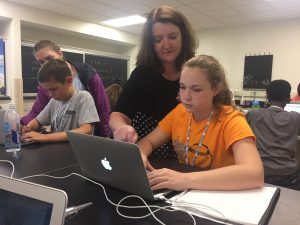Recently, I had the opportunity to drive through the breathtaking Pennsylvania countryside to teach a group of middle schoolers about family history and genealogy at Penn State University. The kids were attending a genetics and genealogy summer camp cleverly named "Finding Your Roots: The Seedlings," where the primary goal was to stimulate interest in science by getting kids to study themselves – their DNA, their bodies, and their family histories – as scientists.
The camp program was part of an on-going formal research project funded by the Robert Wood Johnson Foundation, the National Science Foundation, the Rockefeller Foundation, and the Hutchins Center for African and African American Studies at Harvard, and it was developed by Penn State professor Nina Jablonski and Harvard professor (and host of the PBS series Finding Your Roots) Henry Louis Gates, Jr.
When I first arrived in the science lab, the group was very energetic, despite the early hour. I had prepared a PowerPoint presentation with handouts for the students to learn about the very basics of genealogy. We started with vital records (I showed them my birth record, my grandparents’ 1932 marriage record, and my great-grandmother’s death record), and then moved to census records, military records, newspapers, and cemetery records. Each of the examples came from my own family history, as I hoped photographs and family stories would help keep the children engaged in the topic. And, boy, was I right!!
The first story I told was about my great-grandmother, Mary Rogan, who grew up in a workhouse in County Leitrim, Ireland. Together, the class examined a copy of the 1911 Ireland Census, where my great-grandmother was enumerated with her younger sister, Kate Rogan (aged 6 and 4, respectively), in the workhouse in Mohill. I explained that Kate and Mary’s mother had left the two girls with their dying father in Ireland, while she traveled to the United States to find work. Later, when Kate and Mary were older, their mother sent for the girls to come to New York so that they could be reunited.
Each of the examples came from my own family history, as I hoped photographs and family stories would help keep the children engaged in the topic. And, boy, was I right!!
Well, this story caused quite a commotion. Several of the class members raised their hands in distress: “How could a mother do that??! How could she leave her young children behind?” And before I could speak up, another classmate said, “You don’t know the circumstances. Maybe that was the mother’s only choice! Maybe she did the right thing by leaving to find work in New York.”
The discussion went on for some time – some students agreed, while others disagreed. They even tried to give the situation context, and thought about what it would have been like to be a widowed mother in the early twentieth century. She was an immigrant, and she moved to one of the largest cities in the world. What must that have been like? When we moved on to other records, the students continued to challenge the decisions of my ancestors and their friends. It was a beautiful thing.
The students picked up on a concept that I try to convey to genealogical researchers in all of my lectures and consultations at NEHGS: You must put your ancestors into historical context. Therefore, whether we consider our ancestors’ decisions good or bad, we have an obligation to think about the circumstances in which these people lived. What was the political climate like? What were the laws at the time? What was the social situation?
If we take time to think about our ancestors in their own historical context, we not only learn more about our family members, but also a great deal about history. And this is a great teaching tool! Because students (both young and old) are so much more interested in a historical period or event if they know that their ancestors were directly involved.
It is also a very sneaky way to get someone interested in history!
Part of my lecture was recorded and will be shared as an inspiration to STEM learning on the PBS series website; it will also be used as part of the camp curriculum's teacher support materials as the program spreads out across the country.
Here is more information on the camp project: http://www.findingyourroots.la.psu.edu/about
Share this:
About Lindsay Fulton
Lindsay Fulton joined the Society in 2012, first a member of the Research Services team, and then a Genealogist in the Library. She has been the Director of Research Services since 2016. In addition to helping constituents with their research, Lindsay has also authored a Portable Genealogists on the topics of Applying to Lineage Societies, the United States Federal Census, 1790-1840 and the United States Federal Census, 1850-1940. She is a frequent contributor to the NEHGS blog, Vita-Brevis, and has appeared as a guest on the Extreme Genes radio program. Before, NEHGS, Lindsay worked at the National Archives and Records Administration in Waltham, Massachusetts, where she designed and implemented an original curriculum program exploring the Chinese Exclusion Era for elementary school students. She holds a B.A. from Merrimack College and M.A. from the University of Massachusetts-Boston.View all posts by Lindsay Fulton →
